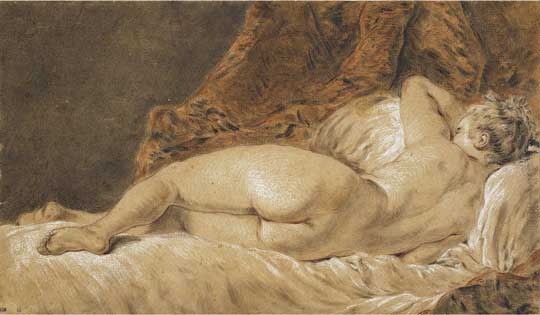

The 300th anniversary of the birth of the French painter Fran�ois Boucher took place in November 2003, an event celebrated by three large exhibitions of his drawings held concurrently in Paris and New York: one at the Louvre, another at the �cole des Beaux-Arts in Paris, and the third at the Frick Collection in New York.
The Art Gallery of New South Wales is fortunate to have the �cole des Beaux-Arts, Paris (ENSBA) exhibition on display from Saturday 5 March to Sunday 1 May 2005. Assembled from one of the foremost collections of Old Master drawings in the world, the exhibition comprises over 80 magnificent drawings. It locates Boucher among his immediate predecessors and contemporaries and shows the extraordinary range of his subject matter including nudes, landscapes, ornamental designs and composition studies. The ENSBA collection was founded with the intention of amassing works of exemplary quality for the instruction of art students in Paris. Its range and quality of French drawings is quite unrivalled.
Fran�ois Boucher was regarded during his lifetime as the foremost draughtsman in France, and was ranked by his contemporaries among the greatest draughtsmen of all time. Given this towering reputation, the demand for his work by collectors ensured not only that Boucher produced drawings and prints steadily and in quantity, but that his works were intensely studied, were well documented, and were treasured for posterity. The nineteenth-century novelists and art critics, the Goncourt brothers, called Boucher 'one of those men who signify the taste of a century, who express, personify and incarnate it'.
The exhibition celebrates Boucher's central role in defining a new style that was taken up by the French aristocracy and Royal court, and which spread through all the royal courts of eighteenth-century Europe. This style became known as the rococo.
In essence, rococo art is a purely French transformation of the Baroque idioms that developed in Italy a century earlier. As opposed to the grandiloquence, operatic emotions, intense religiosity and authoritarianism of baroque art, the rococo style which evolved in France during the reign of Louis XV was intimate, dainty, graceful and pleasure-loving.
Boucher's greatest predecessor, the painter Antoine Watteau (1684-1721) set the tone of the Rococo when he declined to paint the "great subjects" expected from the most accomplished and ambitious painters of the time. One of Boucher's first professional successes was a series of engravings he made after Watteau's drawings. In this exhibition there are eight drawings by Watteau and several examples of Boucher's engravings after Watteau, which enable us to follow the way the rococo style extended the implications of Watteau's art.
Complementing this exhibition at the Art Gallery of New South Wales, there will be a series of concerts of 18th-century music; a film program including such classics as Dangerous liaisons, Tous les matins du monde, and Ridicule; and a series of lectures and drawing workshops.
|